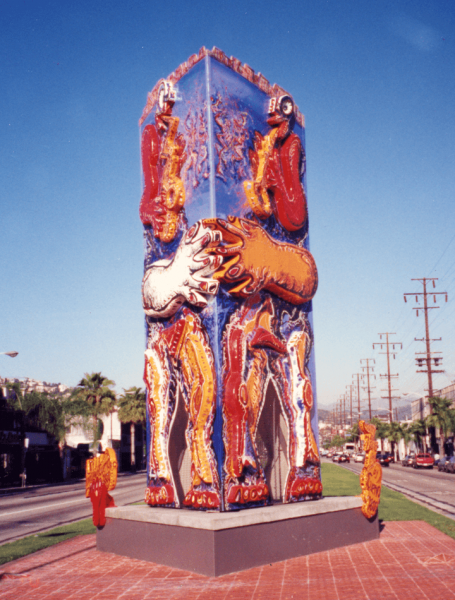
Those who support the renovation of a long-vacant building at 9091 Santa Monica Blvd. near Doheny Drive have called the existing structure an “eyesore” at this key entry point to West Hollywood. They equate the prominently situated building to being an “anchor at the western gateway to the city.”
The 90-year-old, two-story brick building dates back to the city’s storied electric streetcar era. Developer Megdal and Associates is proposing to revitalize it with a ground-floor restaurant and a small hotel upstairs, helping provide what supporters call a “vibrant entrance on the city’s western edge.”

Such attention to this gateway for those entering from Beverly Hills recalls a period in the mid-1990s when another structure drew a great deal of attention. It was a 30-foot-tall, brightly painted, abstract rendition of birds playing saxophones donated to the city by an importer of Mexican tequila.
West Hollywood elected officials accepted the sculpture – with the tequila’s brand name on it – as public art in 1994, agreeing to display it for five years. It was placed in the median of Santa Monica Blvd. across from the building Megdal plans to revitalize. The public outcry that resulted forced the city to have it removed after less than three years.
The Best of Intentions
Heublein Inc., a Connecticut-based importer of Cuervo tequila, spent nearly $400,000 to commission the artwork and for its installation. The piece by renowned Mexican artist Jazzamoart, aka Javier Vazquez, was called “The Cuervotivity . . . Visions of Art Monument.” It was the company’s first foray into public art and meant to be the centerpiece of a Cuervo promotion campaign celebrating Mexican culture, according to the Los Angeles Times.
“In order to make the work more meaningful to residents, (Heublien) said city staff suggested it be connected to a social cause,” the newspaper reported. “The company chose to contribute funds to AHORA, a defunct AIDS social service agency serving Latinos, and added to the sculpture a block of tiles inscribed with the names of people who have died from the disease.” The tequila’s brand name also was displayed prominently on the base.
But the monument quickly became the definition of ugliness, kicking off a debate over what is acceptable as public art and who should make the call. “It’s such an ugly thing,” then-Mayor Paul Koretz said. “I think it’s time to take it down” after it had been on display for 30 months.
The Los Angeles Times had its usual “West-Hollywood-as-the-butt-of-all-jokes” perspective on the incident.
“Any public art that is so tasteless, such an offense to the eye that it may be dismantled by the city of West Hollywood – the city where men dress up like Little Bo Peep for Halloween, and where you can order a birthday cake shaped like human genitalia – is unquestionably worth a drive to see,” wrote Patt Morrison, the “grande dame” of the Times’ newsroom and arbiter of everything in good taste (or not). “Mr. Bo Peep doesn’t bother me – that’s Halloween. The genital birthday cakes aren’t being flashed at a major intersection.”
Some contended the sculpture was more promotion than art and criticized the City Council for not seeking residents’ opinions before approving the work. Even the city’s Fine Arts Board, which wasn’t required to approve the sculpture, considered taking out an ad declaring it had nothing to do with the installation.
Defenders said that even if critics didn’t appreciate the bold style of its Mexican creator, a bad precedent would be set by pulling it down. Some council members and city staff argue that the city should support a project that received unanimous council approval and required a year of planning.
But they were few and far between. “A petition signed by 60 residents describes the work as ‘tasteless’ and ‘offensive,’ and even predicts that it will lower property values of nearby homes,” the Times reported.
Opponents typically voiced opinions similar to that of Donald Deluccio, president of the West Hollywood West Residents Association at the time. He told the newspaper, “The majority of the people think it’s an embarrassment to the city.” Deluccio and others not only reviled the piece, they criticized the council for not seeking residents’ opinions before approving the work. “Our biggest concern about it was there should have been some sort of due process before it was installed,” he said.
Critics won a major concession when the City Council developed a more formal process for the installation of any public art in the city. Since then, all works must receive the approval of a board whose members include residents, business representatives and art professionals. A public art ordinance had been on the books for a decade at that point without any provision for public input. In any case, the artwork was removed by early 1997.
Heublien removed its monument. Other Southern California cities reportedly expressed an interest in the Cuervotivity sculpture, but even its creator told WEHOville he isn’t sure where the monument resides today. “Hopefully, it’s on a college or university campus somewhere,” Vazquez said.

I commend and truly do appreciate the city’s commitment to public art. But it really does seems whoever is the curator needs to have their eyes checked. Time and again I find myself embarrassed by the city’s effort. Why is it West Hollywood – a world famous, if not world class, destination can’t manage to pull this effort off boggles the mind – and hurts the eyes
At least it’s not the $400,000 giant turd statue, San Jose’s Quetzalcoatl.
I don’t know, Mr Booty, if that’s necessarily true, but it is in this case.
i sorta liked it. it was colorful and a little crazy. i couldn’t understand the vitriol. to each his own though.
West Hollywood seems to have cornered the market on the most bad public art per square mile than any other metropolitan pretend city in the world. Congrats!